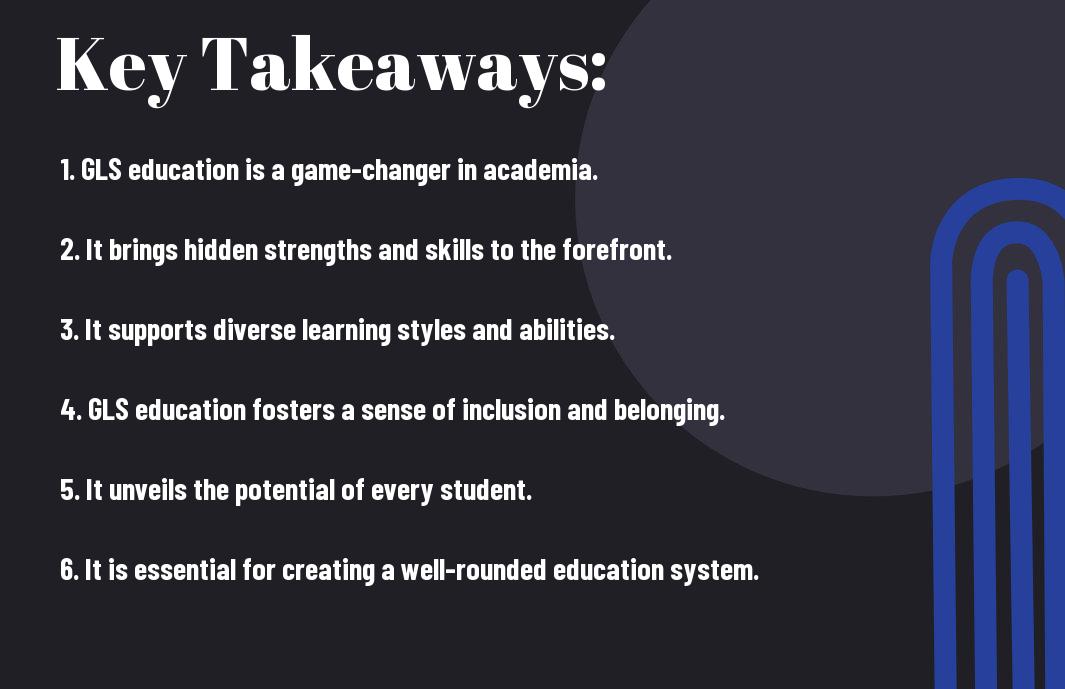Permeating through the corridors of academia, game-based learning systems (GLS) have quietly but profoundly revolutionized the landscape of education. While traditional teaching methods and curriculum development take the spotlight, GLS education has emerged as a silent force, reshaping the way students interact, engage, and retain knowledge. From virtual simulations to interactive quizzes, GLS products are driving a paradigm shift in education by catering to various personas and learning styles. In this blog post, we will explore the underappreciated influence of GLS education in academia and its impact on the future of learning.
Key Takeaways:
- GLS Education is a Silent Influencer: Despite its subtle nature, GLS Education plays a critical role in shaping academic success and student development.
- Its Impact Extends Beyond Academics: While often overlooked, GLS Education has a significant impact on students’ social and emotional well-being, ultimately contributing to their overall success in school and beyond.
- Strategic Integration is Essential: Academia must recognize and strategically integrate GLS Education into the curriculum and school culture to fully harness its potential as a game-changer in education.

The Foundations of GLS Education
Assuming a foundational role in the realm of education, Game-Based Learning, Simulation, and Gamification (GLS) have been quietly revolutionizing the way students engage with academic content. The principles and practices that underpin GLS education are essential to understanding its impact as a game-changer in academia.
Historical Context and Evolution
Foundations of GLS education can be traced back to the early 20th century, with the use of educational simulations and role-playing exercises. Over time, these approaches evolved alongside advancements in technology, leading to the integration of video games and digital simulations into educational settings. With the rise of computer-based learning and the proliferation of interactive media, the historical context of GLS education has paved the way for its current status as an essential component of modern pedagogy.
The Psychological Underpinnings
One of the psychological underpinnings of GLS education lies in its ability to captivate and motivate learners through the use of immersive and interactive experiences. By tapping into intrinsic motivation, the principles of game-based learning and gamification leverage the psychological and emotional aspects of learning, enhancing both engagement and retention of subject matter.
A deeper understanding of cognitive psychology, behavioral psychology, and human motivation informs the design and implementation of game-based learning, simulation, and gamification in education. These psychological underpinnings provide a solid framework for the development of effective learning experiences that cater to a diverse range of learners and learning styles.
“`html
Implementation and Impact
To effectively implement GLS education in academia, institutions need to adopt a strategic approach that ensures maximum impact on student learning outcomes. One key strategy is to integrate GLS principles into the curriculum, providing students with access to resources such as the Katherine G Johnson Computational Research Facility [PDF], which promotes computational thinking and problem-solving skills.
Strategies for GLS Integration in Curriculum
Implementation of GLS principles in the curriculum can be achieved through a multi-faceted approach. This includes incorporating game-based learning activities, virtual simulations, and interdisciplinary projects that foster critical thinking and collaboration among students. By aligning course content with real-world scenarios and challenges, institutions can effectively prepare their students for success in the digital age.
Case Studies: Success Stories from Institutions
With the integration of GLS education, institutions have witnessed significant improvements in student engagement, academic performance, and career readiness. Several institutions have reported success stories, including:
- Institution A: Increased student retention rates by 15% following the implementation of a gamified learning platform.
- Institution B: Saw a 20% improvement in student achievement in STEM subjects after introducing virtual reality simulations.
- Institution C: Reported a 25% increase in student collaboration and problem-solving skills through interdisciplinary GLS projects.
For instance, Institution A implemented a gamified learning platform, resulting in a 15% increase in student retention rates and a positive impact on overall academic performance. These case studies demonstrate the transformative power of GLS education in academia and its potential to drive positive change on a large scale.
“`
Navigating Challenges
Now that we understand the game-changing nature of GLS education in academia, it’s important to recognize the challenges that come with implementing it. These challenges can range from institutional resistance and skepticism to technological and resource constraints. Navigating these obstacles is crucial for the successful integration of GLS education into the academic landscape.
Resistance and Skepticism in Academia
Any major shift in educational paradigms is bound to face resistance and skepticism, and GLS education is no exception. Some academics may be wary of the potential impact on traditional teaching methods, while others may question the validity and effectiveness of game-based learning. Overcoming this resistance requires a well-structured approach that addresses concerns and provides evidence of the positive outcomes of GLS education.
Technological and Resource Constraints
Skepticism may also arise from concerns about technological and resource constraints. Any integration of technology into education requires investment in infrastructure and resources, which can be a significant barrier for institutions with limited budgets. Furthermore, the digital divide among students can also pose challenges, as not all students may have equal access to the necessary technology for GLS education.
As we navigate the challenges of technological and resource constraints, it’s important to recognize the potential benefits of embracing new technologies in education. By leveraging the power of digital tools and resources, institutions can enhance the learning experience for their students and prepare them for the digital world they will enter upon graduation. A strategic approach to overcoming these constraints will be vital in realizing the full potential of GLS education.

The Future of GLS in Education
After years of steady growth and development, it is clear that Games and Simulations (GLS) have firmly established themselves as a game-changer in the field of education. As we look to the future, it is important to consider the potential impact and role of GLS in shaping the landscape of academia.
Innovations on the Horizon
Any discussion of the future of GLS in education would be incomplete without considering the innovations on the horizon. As technology continues to advance, so too will the capabilities of GLS. Virtual reality, augmented reality, and artificial intelligence are just a few of the cutting-edge technologies that will likely play a key role in the next generation of educational games and simulations. These innovations have the potential to revolutionize the way students engage with and learn from educational content, opening up new possibilities for personalized and immersive learning experiences.
Preparing for the Next Leap in Learning
An essential aspect of preparing for the next leap in learning is ensuring that educators and institutions are equipped to harness the full potential of GLS. As we look ahead, it will be crucial for educators to embrace ongoing professional development and training to effectively integrate these evolving technologies into their teaching practices. Additionally, curriculum development and educational policy must adapt to accommodate the rapidly evolving landscape of GLS, ensuring that students are prepared for the future of learning.
Innovations such as virtual reality, augmented reality, and artificial intelligence will undoubtedly shape the next era of educational games and simulations. Educators and institutions must be proactive in their approach to embracing and adapting to these advancements in order to stay at the forefront of educational innovation.
FAQ
Q: What is the concept of Illuminating the Invisible – GLS Education?
A: Illuminating the Invisible – GLS Education refers to the recognition and elevation of the often unseen and underappreciated influence of Global Learning Systems (GLS) in academia. This concept sheds light on the crucial role that GLS Education plays in shaping the academic landscape and driving positive change in educational institutions.
Q: What are some examples of GLS Education as a game-changer in academia?
A: GLS Education serves as a game-changer in academia in various ways, such as promoting diversity and cultural awareness, fostering global collaboration and partnerships, and enhancing cross-cultural communication and understanding. Additionally, GLS Education facilitates the exchange of knowledge, ideas, and best practices across borders, leading to innovative advancements and improvements in educational systems worldwide.
Q: How can institutions harness the power of GLS Education to maximize its impact?
A: Institutions can harness the power of GLS Education by embracing inclusive and diverse learning environments, implementing global learning initiatives and programs, encouraging international student exchanges and study abroad opportunities, and fostering collaborative partnerships with educational institutions around the world. By prioritizing and integrating GLS Education into their curricula and strategies, institutions can maximize its positive impact and effectively prepare students for success in a globally interconnected world.
